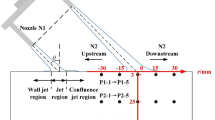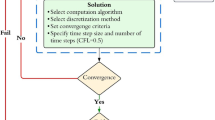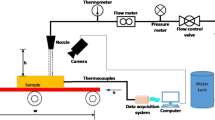Abstract
During cooling, the array jet impact can achieve a rapid and uniform cooling of the high-temperature plate. Previous research results mostly focused on single-jet cooling of thin plates, but the complex flow and heat transfer characteristics between multiple jets could not be obtained. To clarify the heat transfer mechanisms and cooling speed fields characteristics in different flow regions, double water-jet impingement experiments were carried out on an AISI 304 austenitic stainless-steel plate with a thickness of 50 mm. The jet exit velocity was set to 2.95, 5.90, 8.06, and 11.80 m/s, while the jet height was set to 50, 150, 250, 350, and 450 mm. Pure water was selected as the working fluid with a constant temperature of 12.8 °C. The results show that a complex trend with sequential increasing, decreasing, and increasing behaviors appears in the wetting front width, upon increasing the wetting region diameter. The confluence fluid was found to reduce the influence caused by different jet velocities and to increase the influence caused by different jet heights. In addition, it was found that an excessive amount of accumulated fluid reduces the heat transfer efficiency during transition boiling. Finally, the correlations between maximum heat flux and average maximum cooling speed were established, which provide useful data for optimizing the cooling technology.









Similar content being viewed by others
Abbreviations
- ρ s :
-
density of the experimental material Kg/m3
- c s :
-
specific heat of the experimental material J/(kg·K)
- h :
-
the distance to the cooled surface mm
- t :
-
cooled time s
- z :
-
jet height mm
- Q :
-
jet flow L/h
- u :
-
jet exit velocity m/s
- Y :
-
filtered temperature °C
- x :
-
measured temperature °C
- K :
-
measured point mm
- M :
-
time step s
- λ s :
-
thermal conductivity of the experimental material W·(m·K) -1
- r :
-
the horizontal distance between the surface position and jet point; mm
- t min :
-
rewetting time s
- T min :
-
rewetting temperature °C
- t max :
-
complete-wetting time s
- T max :
-
complete-wetting temperature °C
- q max :
-
the maximum heat flux MW/m2
- d :
-
nozzle diameter mm
- Grad:
-
temperature gradient °C/mm
- v max :
-
the maximum cooling speed °C/s
- v ave :
-
the average maximum cooling speed along the horizontal °C/s
References
Seraj MM, Mahdi E, Gadala MS (2012) Numerical assessments of impingement flow over flat surface due to single and twin circular long water jets. Trans Control Mech Trans Control Mech Syst 1:290–299
Sharma AK, Modak M, Sahu SK (2018) The heat transfer characteristics and rewetting behavior of hot horizontal downward facing surface by round water jet impingement. Appl Therm Eng 138:603–617
Agrawal C, Kumar R, Gupta A, Chatterjee B (2012) Effect of jet diameter on the rewetting of hot horizontal surfaces during quenching. Exp Therm Fluid Sci 42:25–37
Nobari AH, Prodanovic V, Militzer M (2016) Heat transfer of a stationary steel plate during water jet impingement cooling. Int J Heat Mass Trans 101:1138–1150
Mozumder AK, Monde M, Woodfield PL, Islam MA (2006) Maximum heat flux in relation to quenching of a high temperature surface with liquid jet impingement. Int J Heat Mass Trans 49:2877–2888
Agrawal C, Kumar R, Gupta A, Chatterjee B (2013) Effect of jet diameter on the maximum surface heat flux during quenching of hot surface. Nucl Eng Des 265:727–736
Qiu L, Dubey S, Choo FH, Duan F (2015) Recent developments of jet impingement nucleate boiling. Int J Heat Mass Trans 89:42–58
Mozumder AK, Monde M, Woodfield PL (2005) Delay of wetting propagation during jet impingement quenching for a high temperature surface. Int J Heat Mass Trans 48:5395–5407
Woodfield PL, Mozumder AK, Monde M (2009) On the size of the boiling region in jet impingement quenching. Int J Heat Mass Trans 52:460–465
Karwa N, Gambaryan Roisman T, Stephan P, Tropea C (2011) Experimental investigation of circular free-surface jet impingement quenching: Transient hydrodynamics and heat transfer. Exp Therm Fluid Sci 35:1435–1443
Hatta N, Kokado JI, Hanasaki K (1983) Numerical analysis of cooling characteristics for water bar. Trans ISIJ 23:555–564
Mozumder AK, Woodfield PL, Islam MA, Monde M (2007) Maximum heat flux propagation velocity during quenching by water jet impingement. Int J Heat Mass Trans 50:1559–1568
Ravikumar SV, Jha JM, Mohapatra SS, Pal SK, Chakraborty S (2014) Experimental investigation of effect of different types of surfactants and jet height on cooling of a hot steel plate. J Heat Trans 136:072102-1-072102–10
Barewar SD, Tawri S, Chougule SS (2019) Heat transfer characteristics of free nanofluid impinging jet on flat surface with different jet to plate distance. Chem Eng Process 136:1–10
Agrawal C, Kumar R, Gupta A, Chatterjee B (2012) Rewetting and maximum sur-face heat flux during quenching of hot surface by round water jet impingement. Int J Heat Mass Trans 55:4772–4780
Paul G, Das PK, Manna I (2015) Rewetting of vertical pipes by bottom flooding using nanofluid as a coolant. J Heat Trans 137:121009–121001
Wang B, Lin D, Xie Q, Wang Z, Wang G (2016) Heat transfer characteristics during jet impingement on a high-temperature plate surface. Appl Therm Eng 100:902–910
Tian XH, Fu TL, Zhang JW, Wang ZD, Wang GD (2020) Effect of nanofluids on liquid-solid heat transfer on high-temperature wall. ISIJ Int 60:1993–1999
Hall DE, Incropera FP, Viskanta R (2001) Jet impingement boiling from a circular free-sree-surface jet during quenching: part 2-two-phase jet. J Heat Trans 123:911–917
Hall DE, Incropera FP, Viskanta R (2001) Jet impingement boiling from a circular free-surface jet during quenching: Part 1—single phase jet. J Heat Trans 123:901–909
Karwa N, Stephan P (2013) Experimental investigation of free-surface jet impingement quenching process. Int J Heat Mass Trans 64:1118–1126
Qiu Y, Liu Z (2005) Critical heat flux in saturated and subcooled boiling for R-113 jet impingement on the stagnation zone. Appl Therm Eng 25:2367–2378
Liu Z, Zhu Q (2002) Prediction of critical heat flux for convective boiling of saturated water jet impinging on the stagnation zone. J Heat Trans 124:1125–1130
Liu Z, Tong T, Qiu Y (2004) Critical heat flux of steady boiling for subcooled water jet impingement on the flat stagnation zone. J Heat Trans 126:179–183
Funding
This work was supported by the National Key Research and Development Programs of China (Grant number [2017YFB0305102]).
Author information
Authors and Affiliations
Corresponding author
Ethics declarations
Conflict of interest
The authors have no conflicts of interest to declare that are relevant to the content of this article.
Additional information
Publisher’s note
Springer Nature remains neutral with regard to jurisdictional claims in published maps and institutional affiliations.
Rights and permissions
About this article
Cite this article
Tian, X., Fu, T., Wang, Z. et al. Heat transfer characteristics for double water‐jets on thick plates with various jet velocities and heights. Heat Mass Transfer 57, 1707–1715 (2021). https://doi.org/10.1007/s00231-021-03062-5
Received:
Accepted:
Published:
Issue Date:
DOI: https://doi.org/10.1007/s00231-021-03062-5




